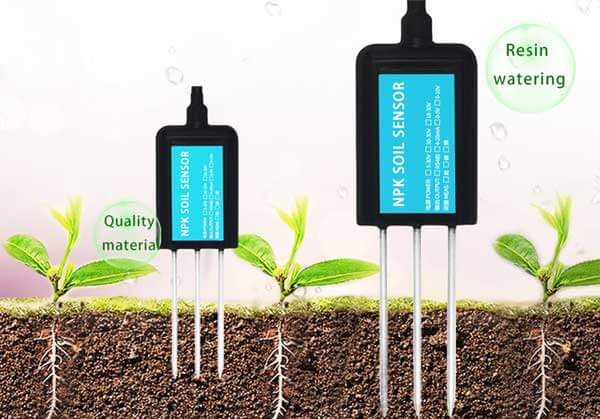Agriculture is experiencing a revolution, driven by advancements in technology. Precision agriculture is transforming farming practices by enabling farmers to make data-driven decisions and optimize crop production. One key aspect of precision agriculture is soil sensor technology, which allows farmers to monitor soil conditions in real-time and make precise adjustments to maximize yields. This article explores the role of soil sensor technology in precision agriculture and its potential in unleashing the full potential of modern farming.

Understanding Soil Sensor Technology:
Soil sensors are advanced devices designed to measure various parameters within the soil, including moisture content, temperature, pH levels, nutrient levels, and salinity. These sensors employ different sensing techniques, such as electrical conductivity, capacitive or resistive measurements, or optical methods, to provide accurate and timely data about soil conditions. This information helps farmers make informed decisions regarding irrigation, fertilization, and other farming practices.
Real-time Soil Monitoring:
One of the primary benefits of soil sensor technology is real-time soil monitoring. Traditional methods of soil analysis involve collecting samples and sending them to a laboratory for analysis, which can be time-consuming and provide delayed results. Soil sensors, on the other hand, provide immediate data on soil conditions, allowing farmers to monitor changes and respond promptly. Real-time monitoring enables farmers to implement precise interventions, resulting in improved crop health and increased productivity.
Optimal Irrigation Management:
Water is a precious resource in agriculture, and efficient irrigation management is crucial for sustainable farming. Soil sensors play a pivotal role in optimizing irrigation practices by providing accurate information about soil moisture levels. By monitoring soil moisture content in real-time, farmers can determine the exact amount and timing of irrigation required. This precision ensures that crops receive adequate water while minimizing water wastage, reducing costs, and conserving water resources.
Nutrient Management and Fertilizer Optimization:
Understanding soil nutrient levels is vital for providing crops with the necessary nutrients for healthy growth. Soil sensors enable farmers to accurately assess nutrient levels and make informed decisions regarding fertilizer application. By measuring nutrient concentrations, such as nitrogen, phosphorus, and potassium, farmers can apply fertilizers more precisely, reducing waste and minimizing the risk of nutrient runoff, which can harm the environment.
pH and Salinity Management:
Soil pH and salinity levels significantly impact plant growth and crop productivity. Soil sensors provide real-time data on pH levels and salinity, allowing farmers to closely monitor these parameters. By understanding soil pH, farmers can make corrections by adjusting pH levels through appropriate amendments. Monitoring salinity levels helps farmers manage the salts in the soil, ensuring optimal growing conditions for crops and preventing salt buildup, which can hinder plant growth.
Site-specific Farming Practices:
Soil sensor technology facilitates site-specific farming practices, tailoring interventions to specific areas within a field. With the help of soil sensors, farmers can identify variations in soil conditions across their farms. This information enables them to implement variable rate applications of inputs, such as fertilizers or irrigation, based on specific needs in different areas. Site-specific farming practices maximize resource utilization, reduce waste, and optimize crop production.
Integrating Data Analytics and Decision Support Systems:
Advancements in data analytics and decision support systems are revolutionizing the analysis and interpretation of soil sensor data. By integrating soil sensor data with other relevant data sources, such as weather data or crop growth models, farmers can gain comprehensive insights into crop performance and make data-driven decisions. These systems provide recommendations regarding optimal farming practices, aiding in precision agriculture and maximizing yields.
Sustainable Farming and Environmental Stewardship:
Precision agriculture powered by soil sensor technology promotes sustainable farming practices and environmental stewardship. By optimizing inputs, such as water and fertilizers, farmers reduce waste and minimize the environmental impact of agricultural activities. Additionally, by monitoring soil conditions closely, farmers can identify areas that require remediation or conservation efforts, promoting soil health and long-term sustainability.

Conclusion:
Soil sensor technology is unlocking the full potential of precision agriculture by allowing farmers to monitor soil conditions in real-time and make precise interventions. By providing accurate data on parameters such as moisture content, nutrient levels, pH, and salinity, soil sensors enable farmers to optimize irrigation practices, manage nutrients efficiently, and implement site-specific farming strategies. This technology empowers farmers to make data-driven decisions, increase productivity, and promote sustainable farming practices. With ongoing advancements in data analytics and decision support systems, the potential of soil sensor technology in revolutionizing agriculture is boundless. As we harness its power, we pave the way for a more efficient, productive, and environmentally conscious future in farming.
